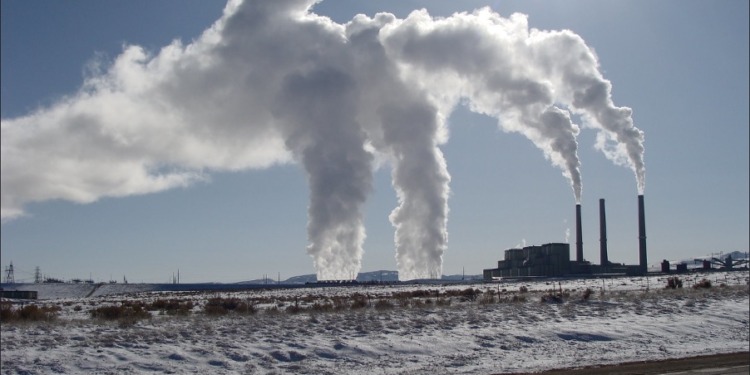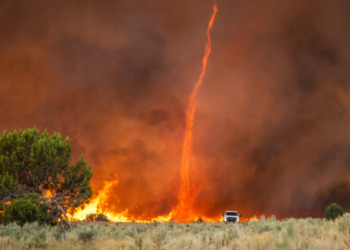Published on July 12 in the Climatic Change journal, a study from researchers at the Dartmouth College Climate Modelling and Impacts group includes data that has the potential to facilitate legal claims against the world’s most polluting nations for losses tied to global warming.
The study finds that the United States and China, the world’s two leading greenhouse gas (GHG) emitters, have caused $1.8 trillion in global income losses annually from 1990 to 2014, which accounts for nearly a third of all the damage done to the global GDP by emissions.
The researchers linked each nation’s GHG emissions to the losses and gains in the gross domestic product of the 143 countries for which data is available (inflation-adjusted for 2010 USD).
The US and China, with the three other top GHG emitters (Russia, India, and Brazil) overall caused an approximately $6 trillion loss in GDP in the same time period, roughly 11% of the total global GDP .
Below are the study’s findings, showing the percentage share of countries’ responsibility for global economic damages from 1990-2014:
- US: 16.52%
- China: 15.84%
- Russia: 8.54%
- India: 7.01%
- Brazil: 4.57
- Indonesia: 4.45%
- Japan: 2.84%
- Venezuela: 2.61%
- Germany: 2.53%
- Canada: 2.14%
Notably, the EU is usually near the top of the global emitters list, but in this study the researchers divided the bloc into individual countries instead.
Important new study in @ClimaticChange_ attributes specific costs of climate change damage to specific emitting countries. Meant to support liability claims, among other things. A pioneering bombshell in light of COP-27 focus on loss and damage.https://t.co/kyxv6GNSAU
— Aaron Cosbey (@AaronCosbey) July 14, 2022
These results make evident that the countries most responsible for the harm to poorer economies tend to be the largest economies that have burned the most fossil fuels and emitted the most global warming gases. The countries most impacted by these emissions are predominantly developing countries in the Southern Hemisphere that were warmer to begin with.
This reflects essential concerns of climate injustice, where climate change’s damages are inflicted elsewhere to where they originate.
Justin Mankin, assistant geography professor at Dartmouth and a co-author of the study accordingly said:
“One of the challenges is the abstraction that global warming presents. What is increasingly clear is that those impacts are not felt equally across the world”
To realise these effects, the study also highlighted impacts on individual countries, such as Bangladesh, a low-lying coastal country vulnerable to rising sea levels, flooding, and extreme heat and humidity. The research finds that the US and China are predominantly responsible for Bangladesh’ economic losses, at $14.1 billion, of climate impacts from 1990-2014, while China is responsible for $13.6 billion, its data shows. Impacts are thus felt in countries like Bangladesh due to geographical vulnerability, as well as the country having less adaptation measures in place due to less funding. The population of Bangladesh may also be more vulnerable to climate impacts due to reliance on water-reliant agriculture, subsistence farming and fishing, and less developed infrastructure and housing.
Mankin claimed that one could “throw a dart at the map” and hit any country in the tropics to find one with a similar plight, such as Indonesia.
The researchers found that the US reduced Indonesia’s economic growth by 0.065 percentage points each year in that same period, which due to its large population and economy, added to an overall $124 billion loss. The researchers said that U.S. emissions produced a 0.054-degree Celsius change in global average temperatures in that period, which resulted in a 0.04-degree Celsius change in Indonesia’s average temperature directly attributable to US emissions.
Dartmouth PHD candidate and the report’s other author Christopher Callahan stressed that,
“This change may seem small, because Indonesia is a warm, tropical country, increases in temperature are quite harmful to its economy […] Every 1-degree increase in its local temperature reduces its economic growth by 1.6 percentage points.”
The economic impacts in the northern hemisphere have been significantly different. The study here found that the economies of Canada, Russia and Scandinavia have instead to some extent benefited from global warming with extended growing periods and new shipping channels opening in previously frozen Arctic areas. Nonetheless, the wildfires, melted permafrost, heat waves experienced in Europe cannot be ignored.
Those who have contributed least to climate breakdown are overwhelmingly the ones experiencing its worst effects.
All #ClimateAction should have #ClimateJustice at its heart to ensure a safe, sustainable environment for everyone on Earth. pic.twitter.com/JnEZZ83WPc
— Environmental Justice Foundation (@ejfoundation) July 15, 2022
Callahan and Mankin’s research is remarkable
It provides a scientific basis for climate liability claims by quantifying each nation’s responsibility for temperature-driven income changes. However, legal cases of climate liability are not a wholly new idea, as where cities have sued the global oil company ExxonMobil for not disclosing to investors the risks of climate damage, the Urgenda case in the Netherlands, and examples of developing countries asking for industrialised nations to pay for “loss and damages” they link to decades of emissions.
However, unlike other studies which have relied on ‘one or two parts’, such as the historical economic effects of global warming on more cooler, Northern, wealthier nations compared to hotter developing southern nations, as well as the effect of individual emission on other countries’ temperatures, the Dartmouth researchers highlight that their research is ground-breaking for its ‘three-step approach’ which Callahan states shows the “culpability of one country to another country, not the effect of overall global warming on a country”, by “uniting disparate strains of work in a single integrated framework”.
Essentially, the study connects the chain of causality between individual GHG emissions to atmospheric GHG emissions, global mean temperature change, how this propagates down to country level and alters temperatures to the economic impacts of these temperature changes on said country. Uncovering these connections is vital as it uncovers the idea of any plausible deniability, revealing that global warming is individually impacted rather than just a widespread problem of collective action.
By attributing numbers to specific emitters, the researchers have established what a country’s specific contribution has been to warming and its economic effects
Understanding how culpable individual actors are means that this research can be used in court cases, as the legal requirement to prove standing in order to sue for climate-related harms means that plaintiffs must credibly link the damage they have suffered to a specific actor responsible for that damage. This means that it is more evident than before how culpable individual actors are.
However, any such lawsuit would likely be very drawn out and complicated, with methodologies challenged, and testing aspects of the study said Michael Burger, the executive director of the Sabin Centre for Climate Change Law at Columbia University.
The Dartmouth researchers’ report comes along other recent studies, such as that Tearfund’s ‘Dying to adapt’ report, which finds that the African countries who are among the least responsible for the climate crisis will have to spend the most to adapt to it, as well as climate liability mechanisms such as the ‘Lives Saved Calculator’. A build-up of this sort of research could work to engage countries in climate action.
What next? Is litigation the solution?
Ultimately, it is uncertain whether such research can guarantee action. So far, US Climate Envoy John Kerry’s office did not respond to CNN’s request for comment on the study, and neither did China’s Ministry of Ecology and Environment. At COP26, the topic of loss and damage was contentious. However, hopefully the data could be useful in the lead up to COP27 and in discussions at the event later this year in Egypt, making discussions regarding climate responsibility easier and clearer.
Discussion regarding the need for big economies such as the US, China, and EU to pay for developing countries’ climate adaption and clean energy transition in climate finance are already expected, having been elusive at past summits and not responded to adequately enough. Before COP26, Kerry told reporters the US supported the idea of loss and damage, but still noted concern about ‘liability’: “I think, obviously, the United States remains concerned about not opening up some legal track with respect to liability, and we don’t intend to do that”.
For climate justice and to alleviate the suffering of communities, it is absolutely necessary that the world’s wealthiest countries finalise their payments in full to the global climate finance fund and adhere to past promises this year at COP27. High emitting nations must ensure they fully deliver $100 billion in climate finance, with 50% for climate adaptation, that they pledged to deliver each year from 2020-2025 in 2009.
Having a comprehensive set of data to show how much poorer nations’ economies have been harmed could increase the pressure on richer nations, making responsibility difficult to ignore, although some also react badly to this idea of ‘pointing fingers’ and asking for reparations.
On this, Mankin stated that “large emitters have every incentive to prevent climate liability claims from moving forward”, so regardless of outcomes in court, informing and empowering claims of restitution is absolutely essential to moving climate mitigation forward. Raising awareness should also raise the cost of continuing emissions as has been done for last century. The study should attract attention. It is concrete data showing climate responsibility in a way that has been inaccessible until now.
Editor’s Note: The opinions expressed here by Impakter.com columnists are their own, not those of Impakter.com. — In the Featured Photo: Craig Power Station in Moffat Country, Colorado. Featured Photo Credit: Flickr.










